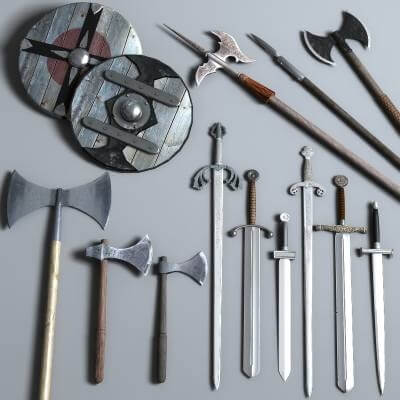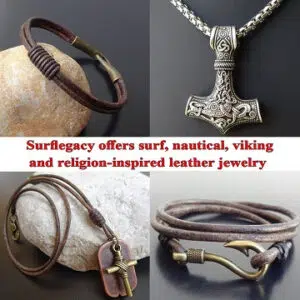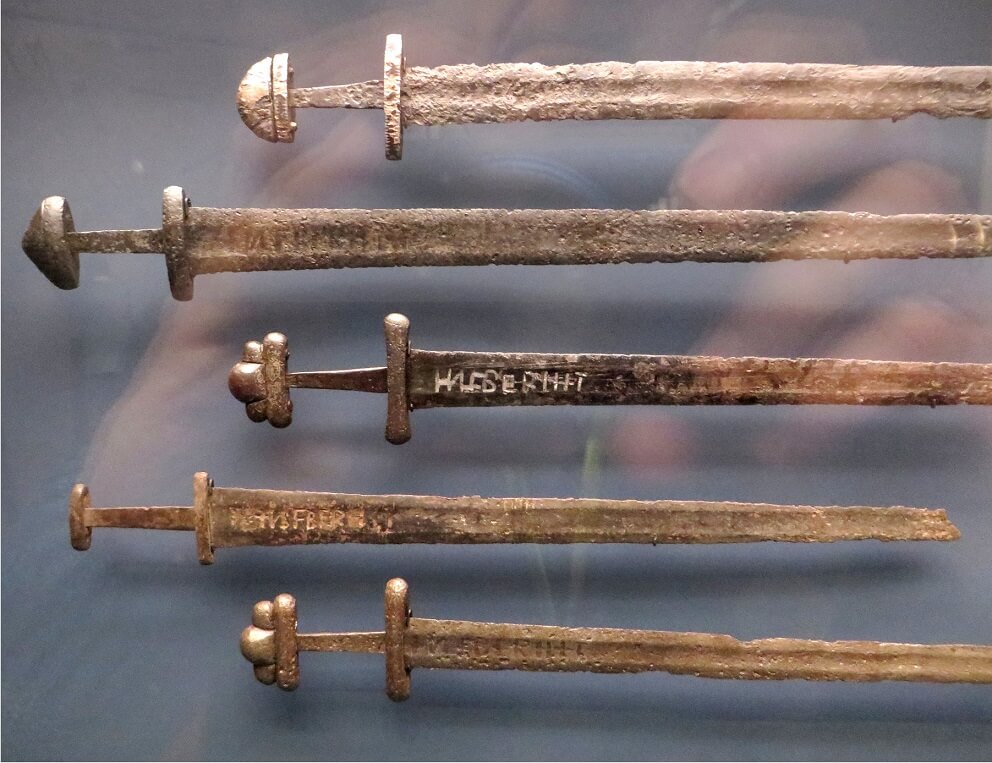Viking weapons are a topic that continues to generate interest despite centuries having passed since the decline of the Viking Age. If the Vikings are known for anything, it is for being skilled warriors.
Their feats in combat allowed these Nordic people to subdue many populations. The victories obtained on the battlefield were not only due to their courage, which was not the only factor that made the Vikings better warriors than their contemporaries, but the weapons they used also made a significant difference.
Vikings had advanced weapon-making technology, which turned them into master warriors. The Viking weapons, in fact, were built with specific purposes, in order to give their best in battle and looting.
See also our article “10 Best Legendary Norse Mythology Weapons“
What did Viking Weapons Look Like?
As we know, The Viking Age took place in the Middle Ages, between the eighth and thirteenth centuries. In that period we will not find among the Viking weapons great advances over those of their contemporaries. Basically, weapons were divided in 2 categories those for close combat and those for throwing.
Since the Vikings specialized in raids, offensive weapons are most often mentioned; however, they also had defensive weapons in their war equipment, which served to protect them from enemy attacks.
In a society as dangerous as that of the Vikings, carrying a weapon was almost a necessity. Unexpected raids and clashes between clans and wild beasts were very common and more than enough reasons to be armed. That’s why the Vikings always brought weapons with them and slept with them next to their bed or always at hand.
Viking Weapons
Although in some cases the Viking chiefs paid for their warriors’ weapons, most freemen had to pay for them or make them themselves. In fact, carrying a weapon was considered a fundamental right and was a symbol of the status of each inhabitant. That is why we find weapons so decorated with engravings and inlays of gold, silver or precious stones.
All men were familiar with the handling of weapons from childhood. However, most of them were not professional warriors, but farmers organized into clans.
Generally, women did not handle weapons except in cases of necessity. Attacking an unarmed man was considered dishonorable, and because women were unarmed, any assault on them was considered a dishonorable act. Although very unusual, weapons have been found in the graves of some Viking women.
As we know, the Vikings did not use any form of writing to pass down their stories during their reign. Therefore, there are no reliable documents from that period that describe the weapons they used during the fighting.
Therefore we have to rely solely on the archaeological records and the artifacts found, which are the most reliable source for what concerns Viking weapons.
Viking weapons have been found in graves, sunken boats, and battlefields.
So based on these findings, we can say that the Vikings used the following weapons:
- Axes
- Swords
- Knives
- Spears
- Bows and Arrows
Axes
The typical Viking image is always associated with an axe, for a very simple reason. The Viking axe was an inexpensive, common, and versatile weapon, as it could be used both for farming, if necessary also as a defensive tool.
It was mainly for reasons of practical use that among the Vikings the axe became the most common tool for everyday use and also in battle. Producing an axe was for sure, much cheaper and more convenient than making a sword. The axe was the weapon of choice for the common Viking warrior who could not afford a sword.
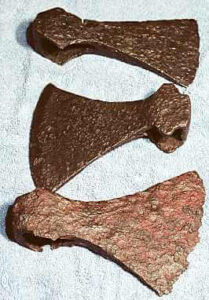
The axe is an apparently simple tool, but in its simplicity are hidden the characteristics that make it an extremely versatile weapon: if it is held away from the blade it can deliver powerful blows, capable of easily splitting wooden blocks or breaking through shields or light armor; if instead is held with a “higher” handle, it becomes a useful tool for working wood with precision or inflicting fast and deep wounds like a knife.
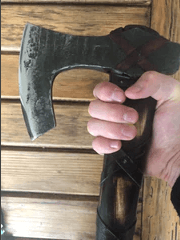
The battle axe was different from that used for work, was generally smaller and lighter then the regular utility axe, for greater maneuverability and with a narrower blade, but very sharp, in the hands of an experienced warrior, this type of weapon could cut even a helmet or pierce an armor.
In general, there were 3 different types of axes, each with their own pros and cons
- Hand axe, often used with the protection of a shield
- Throwing Axe, which was brought behind the belt usually by foot soldiers and then literally hurled against the opponent.
- Big axes or two-handed axes, devastating, but with a great risk of not being protected at every blow.
The axe was a very versatile weapon during combat, however, its versatility required that the head of the blade was firmly engaged in the handle to withstand impacts, pulls and thrusts.
It was not uncommon for the head of an axe to detach from the handle during battle if the point of engagement was not firm enough, leaving the warrior armed with a simple stick.
In the Harðar saga we find one of the most famous testimonies of this type of accident, the warrior Harðar after killing six men with his battle axe, the blade, unfortunately, detached from the handle, leaving the warrior unable to defend himself from enemy blows, resulting in death.
Swords
The weapon of choice, inseparable from every Viking who could afford it. Owning a sword was a matter of high honor. The poorest farmers generally used an axe, but normally after a couple of raids, they had enough money to buy a sword. A sword was valued at about half a crown, which would correspond to the value of 16 milk cows.
During the Viking era, the sword was for one-handed use to be combined with a shield, it had a double-edged blade and it became slightly longer than the Roman-Barbarian spatha, exceeding 90 centimeters in total length.
It had a blade of about 60-80 centimeters, with deep grooves along its length, to increase its power and flexibility, while reducing its weight, thus allowing the user to operate faster and harder blows and allowing the sword to bend without breaking on contact with bone.
The Vikings were not great swords makers. The construction of a sword was a highly specialized task and for this reason, they were often imported from foreign lands, such as the Rhineland.
The forging of a sword could take up to a month of work and given the value was handed down from generation to generation, many swords were also given names.
In the tombs were sometimes found swords with the blade bent so that it was unusable. This custom had the dual purpose both of withdrawing the weapon from his work when the owner died and of dissuading tomb thieves from stealing it.
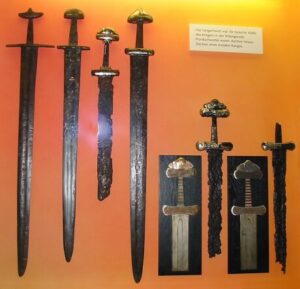
Viking swords Picture taken by viciarg at the Vikingermuseum in Haithabu, Germany
Knives
The knife was the best all around resource, after the axe. There were two types of knives one more common and simple, with a single blade called knifr, this type of knife was found very often in the tombs because very common and even slaves could use it.
The smaller versions were for daily use while those larger were intended for hunting or combat, sometimes the blades had ornamental inlays. The second type of knife widespread was the seax it was a knife with a long blade between 30 and 60 centimeters and a handle in poor materials such as wood, horn, or bone. only free men could wear weapons in public and the presence of a sax on the belt made immediately recognizable the social rank of an individual.
Even if one had sufficient funds to purchase a sword, the weapon would have been wasted for daily and heavy uses such as cutting hard materials or working on an animal carcass; for this kind of heavy work a shorter blade was needed, resistant, heavy and cheap, a knife of medium-long size and versatile enough to be used both daily as a tool and in battle as a last offensive weapon.
Around the seventh century AD, for example, made their appearance the first lang seax (long sax), more similar to swords than to knives, but with a double-edged blade and lighter than the shorter models. Most saxes, however, have only one cutting side and a single curvature of the back or edge.
Given its widespread use among the freemen of central and northern Europe, most seax knives were made by local blacksmiths rather than specialized armorers.
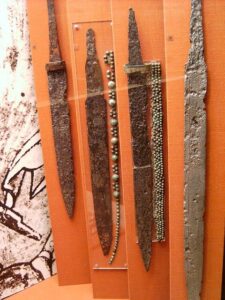
Merowingian seaxes Württembergisches Landesmuseum Stuttgart
The blade of a seax was of simpler and coarser workmanship, tending to be heavier and thicker than that of a sword made by an expert armorer, with a back (the non-cutting side) up to 8 millimeters thick.
The main function of the seax was to cut or truncate with speed and efficiency; its low manufacturing cost, simplicity, and ease of repair thus made it a durable and repairable tool for daily use by most unskilled blacksmiths living in small rural communities.
Although its use was primarily unrelated to battle, the sax proved to be an excellent close combat weapon on numerous occasions, becoming for some warriors a preferable weapon to the sword when the enemy reached its range.
The most famous is the seax of Beagnoth exposed to the British Museum of London, considered a very prestigious weapon, is the only one found that presents on the blade the complete incision of the runic alphabet.


Seax of Beagnoth British Museum
Spears
Like all warriors of their time, the Vikings also used spears. It was a particularly common weapon. There were light spears designed to be thrown and heavier spears for close combat Much evidence shows that it was used one-handed. Some sagas mention that it could be used two-handed, but not in battle.
The spears had metal points that could measure between twenty and sixty centimeters. These points were mounted on wooden shafts that were two or three meters long. The point was secured with a pin, which was often removed to prevent an enemy from reusing it (presumably, the point fell off if you missed the target).
Compared to a sword, the spear could be made from more economical metal, making it cost-effective and easier for any blacksmith to build.
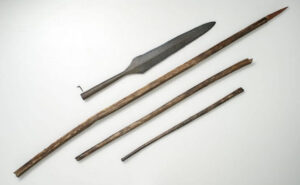
Viking Spear, Vegard Vike, Museum of Cultural History
Bow and Arrows
Bows and arrows may not be the first weapons that come to mind when we talk about the Vikings. But some archaeological evidence suggests that they played an important role during the Viking age.
Bows were mainly used for hunting, in the vast and often icy landscapes of Scandinavia, hunting was challenging and it would have been difficult to get close to wild animals without being seen. In these situations, the use of the bow was indispensable for hunting, as it allowed the hunter to aim at the prey from a distance without alerting the animal of their presence.
Bows were also very useful in battle, especially in those situations where it was necessary to hit the enemy from a distance, as for example in nautical battles, where arrows were shot at the decks of enemy ships in order to clear them before boarding actions.
It is unclear whether there were Viking warriors who specialized in arrow shooting. Vikings probably used their bows in the early stages of the battle, and then switched to bladed weapons in close combat.
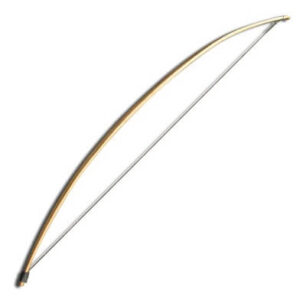
Replica of Viking Bow
They were made of yew, ash or elm and typically between 160 and 200 cm in length Unfortunately because bows were made of these organic materials, not many examples have survived from Viking times to the present day, nevertheless, one of the most important bows was found in a Viking village in Hedeby this bow was considered a battle bow with a shooting power that could reach a distance of about 480 mts, when average bows usually reached about 230 mts
Arrowheads were typically made of iron and produced in various shapes and sizes, depending on where they came from. Among the materials used in addition to metal were wood, bone or antler.
Arrows with eagle feathers glued have also been found. Those with fine points were used to pierce the chain mail, while while the wider points were used to make extraction difficult and inflict more damage.
Conclusion
Certainly, Viking weapons played a fundamental role in the Viking Age, as wars were an integral part of the life of the Nordic peoples.
Their raids made them known to the whole world, but the Vikings were not only skilled warriors, over time they also proved to be skilled traders and craftsmen, in a nutshell, they were not only rough and unruled people, but indeed quite the opposite.
Where to find the ideal Viking Jewelry
Finding the ideal Viking Jewelry can be challenging if you lack inspiration or don’t know where to look.
Surflegacy, on the other hand, has you covered. We have a wide range of Norse Jewelry in various styles, shapes, colors, and materials, to accentuate your Viking look. Our pieces are crafted in Italy with care, style in mind, and reasonably priced, so you won’t have to break the bank to get one.
Visit our store and let us assist you on your fashion journey.

